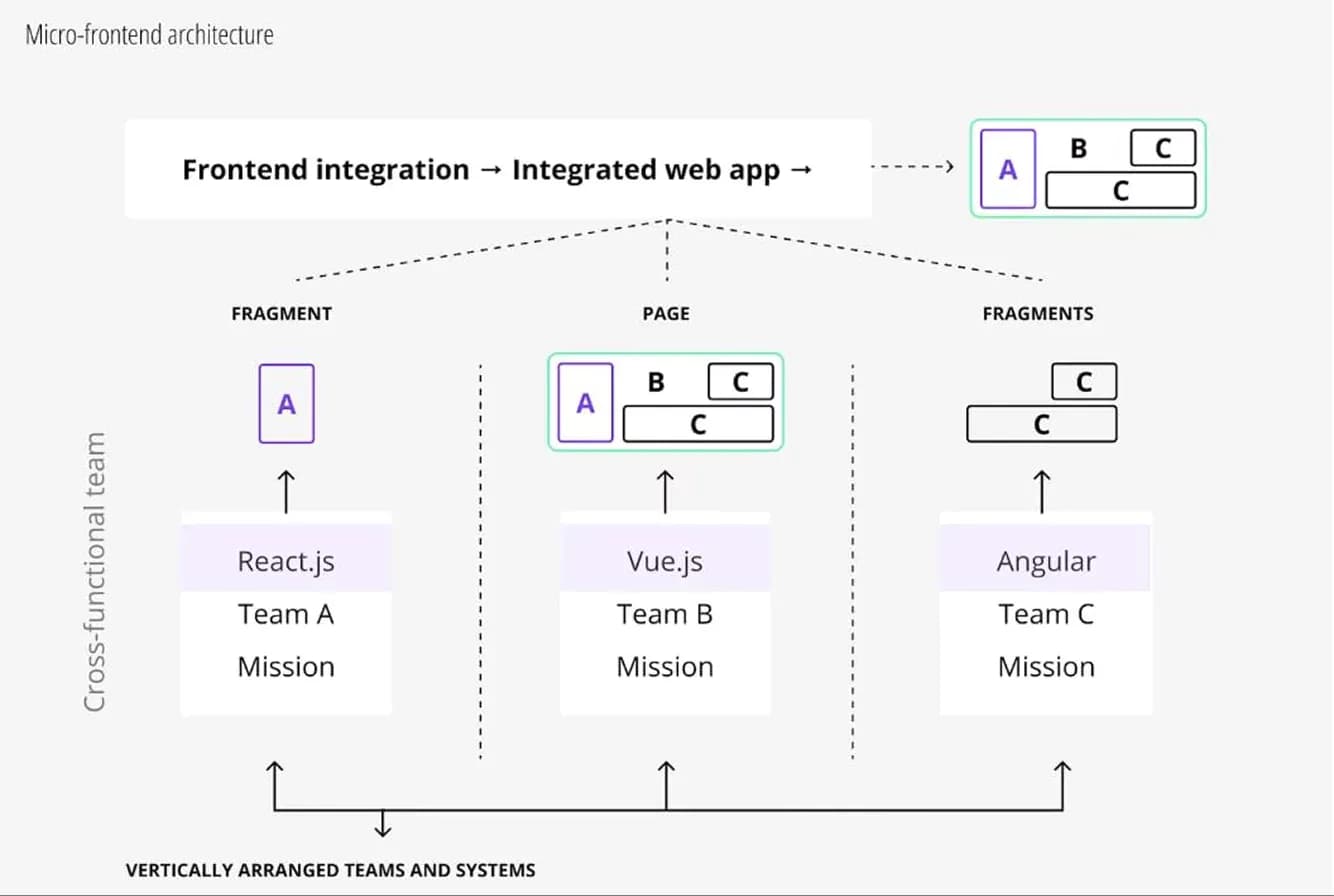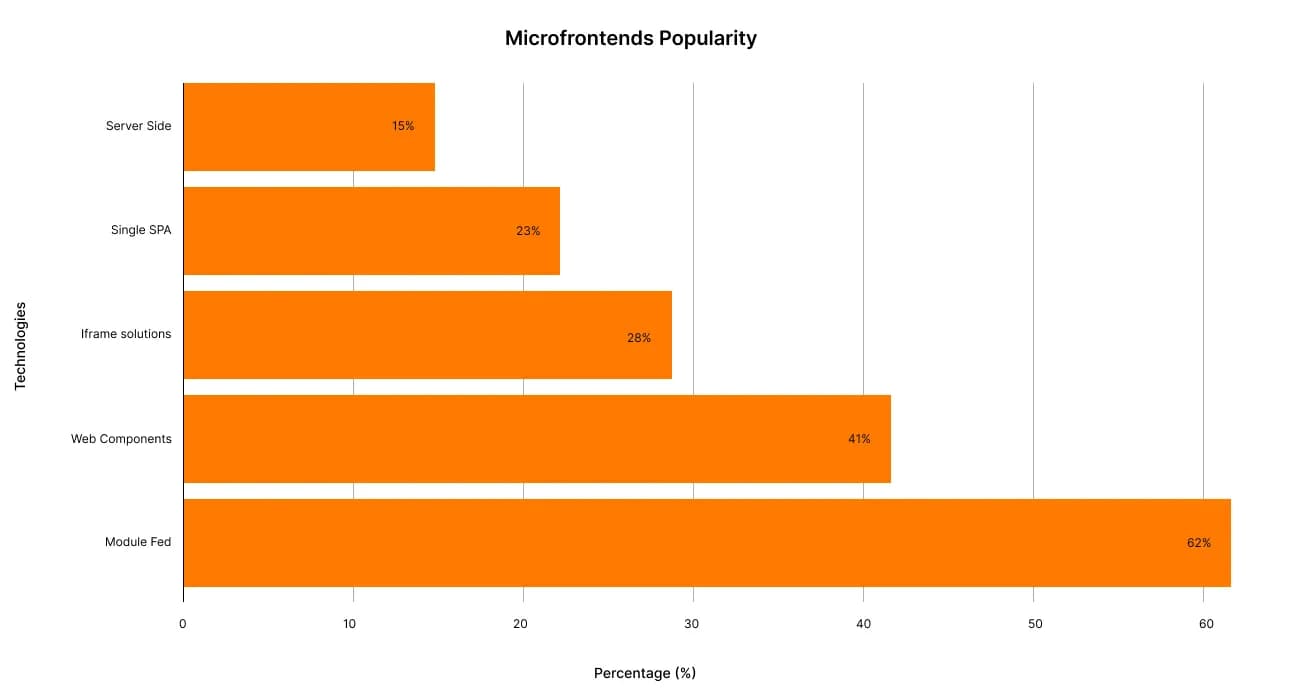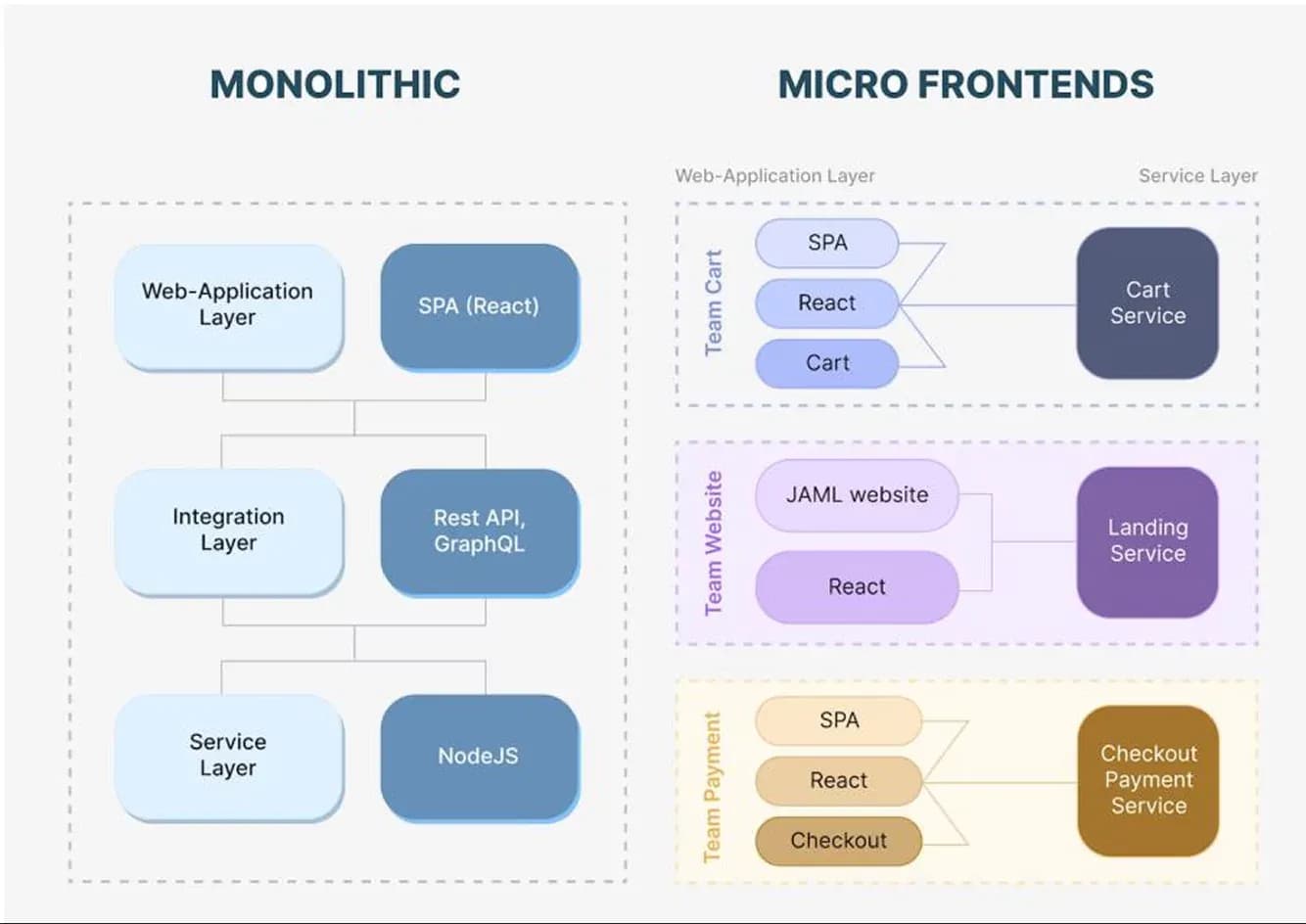Back
Updated at: October 11, 2025
Microfrontends: how to turn a monolithic interface into a scalable modular system

Imagine that you are working in a team of fifty developers on a single web application. Every change requires dozens of approvals, deployment is accompanied by conflicts, and adding a single feature can disrupt the operation of completely unrelated parts of the system.
Sound familiar? These are the problems that microfrontend architecture solves - an approach that brings the principles of microservices to client applications.
According to O'Reilly (2024), 24% of development companies have already implemented microfrontend architecture, and another 29% plan to do so within a year. Netflix, Spotify, IKEA, and other technology leaders are actively using this approach to scale development and accelerate the release of new features to market.
What are microfrontends and why are they needed?
Microfrontends are an architectural pattern in which a monolithic user interface is broken down into smaller, independently developed and deployed modules.
Each team is responsible for its entire module - from the database to the user interface - and chooses its own technology stack and development lifecycle.
Together, all modules are combined into a single application, but each team is completely autonomous.
The main idea is to think of a web application as a composition of functions assigned to specific cross-functional teams that know their business domain best.

Independent teams use React, Vue, and Angular to develop modular frontend fragments combined into one integrated web app.
Evolution: from monolith to modularity
Microfrontends emerged as a logical continuation of microservice architecture. While the backend has long been able to divide applications into independent services, the frontend has long remained the “last monolith.”
In large organizations, this leads to a number of problems:
- Increased coordination costs - synchronization between teams becomes increasingly difficult.
- Long release cycles - the need to test the entire application.
- Accelerated technical debt - due to the complexity of refactoring a huge code base.
- Blocking dependencies - one team waits for another, slowing down the release of new features.
Key principles of microfrontends
The foundation for efficiency:
- Technological independence
Each team uses and updates its own technology stack without having to coordinate with others. React, Angular, and Vue.js can coexist in the same application. - Code isolation
No shared execution environment or global variables, so modules are self-sufficient. - Team prefixes
Naming conventions (CSS, events, LocalStorage, cookies) with unique prefixes to avoid collisions where isolation is not possible. - Priority of native browser capabilities
Use Web APIs and native functions to improve stability and performance.
Implementation approaches and technologies
There are several popular implementation approaches, each with its own advantages and characteristics.

According to 2024 developer surveys
Module Federation (Webpack 5)
An innovative feature of Webpack 5 that allows modules to be loaded dynamically at runtime.
Advantages:
- Load modules without reloading the page.
- Share dependencies between applications.
- Independent deployment of each microfrontend.
- Omnidirectional hosts option - create applications that can be both a host and a remote module at the same time.
Web Components and Custom Elements
A set of standards that allow you to create reusable elements with encapsulated styles and markup.
Advantages:
- Framework agnosticism - works with any libraries and frameworks.
- Native browser support.
- Standardized approach.
- Style encapsulation via Shadow DOM.
SingleSPA
A meta-framework for microfrontends that provides top-level routing and lifecycle management for microapplications.
Features:
- Application-level routing - each microfrontend is activated by specific routes.
- Lifecycle management - clearly defined bootstrap, mount, and unmount methods.
- Support for any frameworks via adapters.
IFrame-based solutions
One of the oldest but still applicable approaches.
Advantages:
- Complete isolation - each application in its own context.
- Technology independence - any combination is suitable.
- Security - natural isolation from cross-site scripting.
Disadvantages: problems with design adaptability, SEO, and performance.
Real-life cases
Netflix
To scale its internal platforms, Netflix developed the Lattice system, focused on the Revenue and Growth teams. The architecture is built on:
- Metadata-driven approach - plugins are described through configuration rather than hard-coded.
- Weak dependencies - modules interact via HTTPS.
- Reuse of React code - faster development with fewer redundant builds.
- High scalability - handling peak loads of up to 110,000 requests per second in 200 countries.
Spotify
Spotify used an iframe-based architecture within its Squad Framework.
- The desktop app consists of thousands of iframes.
- Module interaction via window.postMessage.
- Each squad chooses technologies and is fully responsible for the product.
IKEA
IKEA implemented microfrontends using Edge Side Includes (ESI) and Client Side Includes (CSI).
- CDN-level caching accelerates content delivery.
- Dynamic composition of pages on the server reduces frontend load.
- Scales to millions of users of the online store.
Delivery Club
Delivery Club applied Module Federation in its restaurant accounts.
- Host app manages authorization and navigation.
- Remote modules have their own routes and data stores.
- Isolated releases allow safe independent updates.
Pitfalls

Monolithic vs. Microfrontend Architectures: a comparison of modular components of teams for scalable web development.
Despite the obvious advantages, the implementation of microfrontends comes with challenges:
- Increased technical complexity - requires high-level architects, careful design, and complex CI/CD pipelines.
- UX issues - inconsistent design without a shared UI library; runtime errors lead to heavy bundles.
- Dependency management - multiple package.json files create version conflicts and library incompatibilities.
- Performance degradation - multiple HTTP requests and duplicate dependencies increase load times.
- Vendor lock-in - reliance on SingleSPA or Module Federation ties a company to a specific stack.
Best practices for implementation
To reduce risks and increase efficiency, companies develop comprehensive approaches:
- Organizational measures
Establish Centers of Excellence (CoE) for standardization, training, and architectural oversight. - Technical architecture
Use a Unified Design System and shared component libraries (72% of teams do so). - Infrastructure and DevOps
Automation is critical: 68% of teams use build optimization tools. Implement centralized logging, monitoring, and observability. - Testing
Multi-level testing strategy: - Unit tests per module.
- Integration tests for interactions.
- End-to-end tests for core flows.
- Visual regression tests for design consistency.
When to choose microfrontends
Appropriate if:
- More than 10 developers are working on the project.
- The product spans multiple business domains (marketplaces, SaaS platforms, enterprise portals).
- Teams are cross-functional and can handle the full lifecycle.
Alternatives:
- Modular monoliths for medium-sized teams (5–15).
- Monolithic frontend + microservices backend if APIs are well defined.
Future and trends for 2025
- AI integration - dependency analysis, module separation, AI-powered testing.
- WebAssembly (WASM) - run non-JavaScript code directly in the browser.
- Edge Computing - moving logic to CDNs reduces latency.
- Standardization - Web Components, Import Maps, ES Modules, and Module Federation v2 with TypeScript support.
Conclusion
Microfrontends are not just a trend but a practical tool for scaling frontend development. They enable autonomy, faster delivery, and flexible scalability, but require mature engineering culture, strong DevOps practices, and architectural expertise.
They should be considered a strategic choice for organizations where monolithic architecture hinders growth. For smaller teams and simpler products, traditional approaches may still be more efficient.
If you want to turn complexity into a competitive advantage, explore how microfrontends can transform your product. The team at We Can Develop IT helps companies implement architectures that scale with the business and open up new horizons for growth.
Let’s build a platform together that works for tomorrow’s goals, not just today’s.
Summary:
Microfrontends represent an architectural pattern designed to address the challenges of developing large web applications with numerous teams. This approach involves breaking down a monolithic interface into smaller, independently developed modules, allowing teams to work autonomously and select their own technology stacks. As a result, microfrontends aim to reduce coordination costs, shorten release cycles, and manage technical debt more effectively. Companies like Netflix, Spotify, and IKEA have adopted this architecture to enhance their development processes and expedite feature releases. Key principles of microfrontends include technological independence, code isolation, and a focus on native browser capabilities. Various implementation methods exist, such as Module Federation, Web Components, and SingleSPA, each offering distinct benefits. However, transitioning to microfrontends can introduce complexities, including potential UX inconsistencies and increased management of dependencies. Best practices for successful implementation underscore the importance of organizational measures, technical architecture, and comprehensive testing strategies. Organizations should consider microfrontends when their projects involve large teams and span multiple business domains. Ultimately, while microfrontends offer significant advantages for scaling frontend development, they necessitate a mature engineering culture and robust architectural oversight.
Read also:
microfrontends
frontendarchitecture
modularsystem
webdevelopment
scalablefrontend
modularfrontend
monolithvsmodular
react
angular
vuejs
singlepageapplication
SPA
webpack5
modulefederation
webcomponents
customElements
singlespa
iframearchitecture
frontendengineering
frontenddesignpatterns
frontendbestpractices
netflix
spotify
ikea
deliveryclub
devops
softwarearchitecture
frontendscalability
modernfrontend
webtrends2025
wasm
edgecomputing
standardization
microservices
frontendmodules
frontendtesting
webapps
enterprisefrontend
largeScaleApplications
frontendteams
webperformance



